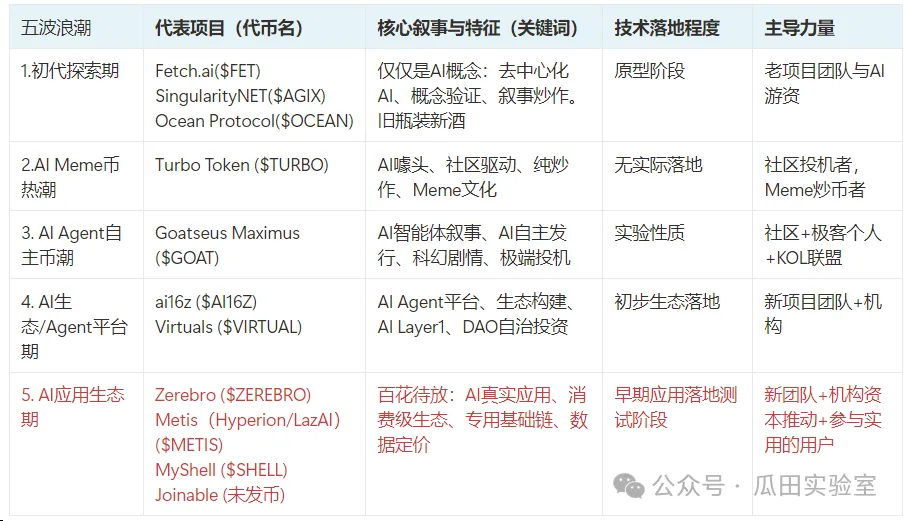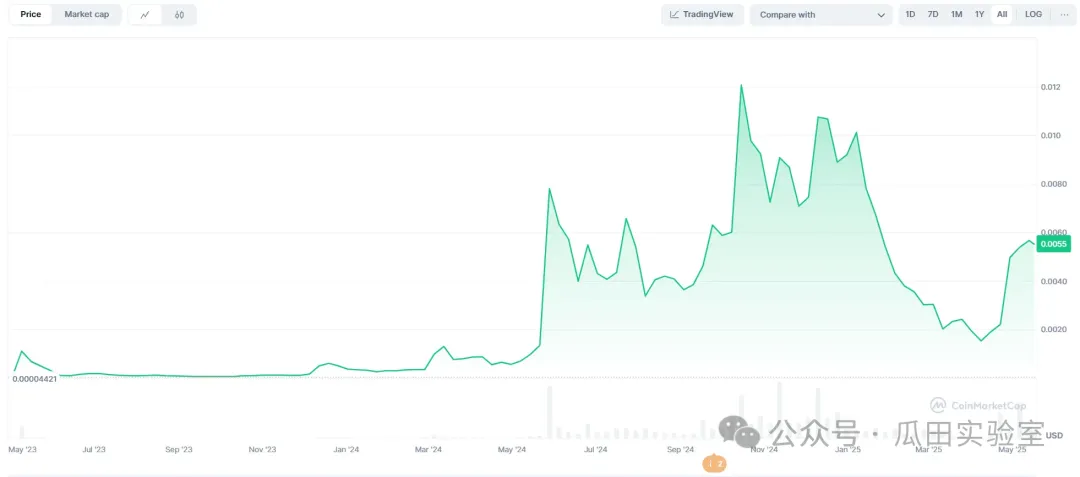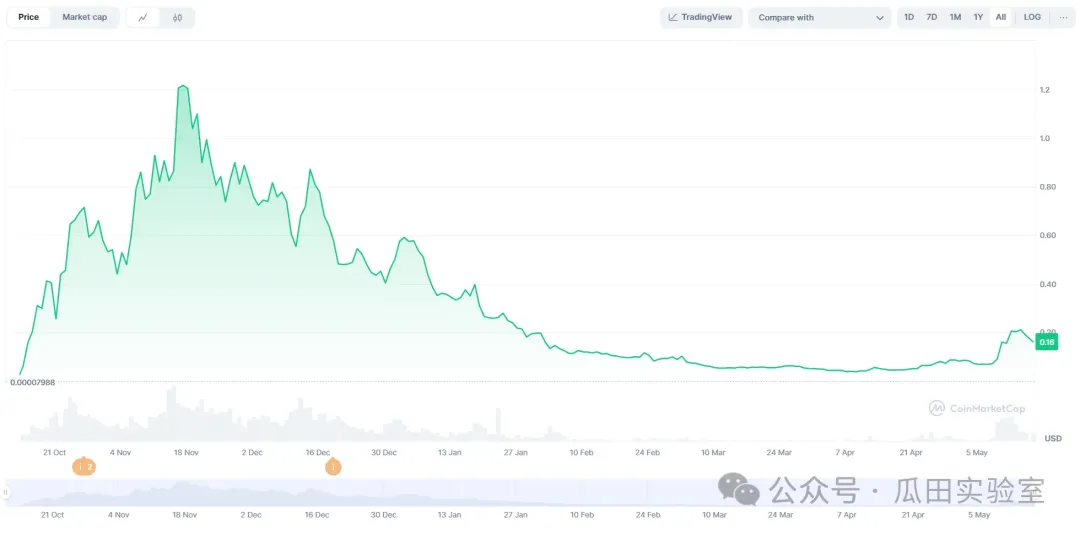introduction
We found that every time we start to study the industry, there is always a big market in the crypto market. BTC has broken through 100,000 U, and ETH has even reached 2,500 U. Haha, is it the so-called God rewards hard work? Just kidding, it’s actually because the United States and the United Kingdom have reached a trade agreement, and the initial talks between the United States and China are not bad (after Trump’s tweet, the two countries confirmed it). It still shows that the entire crypto industry is still a high-risk financial speculation market. Following the economic environment, it has not yet formed an independent market like gold and oil. This also strengthens our search for breakthroughs in the crypto field that can develop in the long term, and AI + WEB3 is the track we value most at present.
In this article, we will continue with the previous article and review the five waves of AI development in WEB3 in recent years. Here we will summarize it with a table. Of course, we will focus on the current fifth wave:

A review of five waves of Web3 AI projects
Since the intersection of blockchain and AI, the crypto field has experienced five major waves of AI concept enthusiasm . Each wave of enthusiasm is led by representative projects or events, showing an evolution from pure concept hype to gradual technical exploration.
01. The first wave (early exploration period) - Fetch.AI and other AI concept coins are emerging: new wine in old bottles
As early as 2018-2019, there were projects that tried to combine blockchain and AI concepts, but the impact was very limited. What really triggered the first round of enthusiasm was the market reaction after the launch of ChatGPT in early 2023. OpenAI's ChatGPT became popular at the end of 2022, allowing the public to see that the power of AI has entered the general civilian field. It feels a bit like the explosion of the Internet after the popularization of home computers more than 20 years ago, and the hot sales of smartphones 10 years ago led to the craze for mobile Internet products. The emergence of ChatGPT makes ordinary users really feel that it can increase their work efficiency.
It should be said that one of the characteristics of the crypto circle is that "any hot spot can be speculated", so ChatGPT has triggered the Crypto market's infinite imagination of the prospects of "AI + blockchain". Since January 2023, the prices of a batch of early AI concept tokens have soared, opening the first wave of the market. A typical representative is Fetch.ai (FET): As an early project of Binance Launchpad, claiming to build a decentralized AI agent network, the price of FET tokens rose rapidly in January 2023 (several times in one month), and the market value once exceeded 200 million US dollars. During the same period, AI-related currencies such as SingularityNET (AGIX) and Ocean Protocol (OCEAN) also led the market.
The characteristics of this stage are: old projects tell new stories - many AI concept coins issued from 2017 to 2019 have been revived with the help of ChatGPT and become the focus of capital pursuit. However, at that time, the products of these projects were mostly in the early stage, with few applications, and the increase mainly came from market sentiment and the vision of the AI trend.
02. The Second Wave - This Round of "Crypto Bull Market" Gives Birth to AI Meme Coins
If the continued strength of BTC since the end of 2023 is defined as the core theme of this round of "crypto bull market", then there are only two tracks that have made waves in the meantime: one is the inscriptions and runes classified as part of the BTC ecosystem, which have brought a lot of heat with the issuance of innovative assets; the other is the Meme track.
Some meme projects have begun to incorporate AI concepts, and as generative AI continues to gain popularity, the Crypto community has begun to see an AI meme coin craze. A typical case is $TURBO, which is said to be the world's first meme token created by AI. Digital artists used ChatGPT to help design and issue TURBO tokens, with a starting capital of only $69. Unexpectedly, this frog-themed meme coin "planned" by artificial intelligence skyrocketed in a short period of time after its launch, attracting a large number of retail investors. TURBO became popular with its unique story of "AI creating the next great meme coin". After landing on many mainstream exchanges, its price rose hundreds of times in just a few weeks, and its market value once ranked among the ranks of popular meme coins.
The core feature of this wave is that AI has become a gimmick and integrated into the crypto subculture. A large number of new projects claim to combine AI tools such as ChatGPT and Midjourney to generate coin names, images or plots, and launch meme tokens with various AI elements. On the one hand, investors are inspired by the AI wave, and on the other hand, they rush into these high-risk tokens with a gambling mentality. However, in essence, these meme coins have no AI technical content, but are just community games that hype the concept of AI. For example, TURBO itself does not have any application functions, and "AI-driven" is just a gimmick for issuance, and its value is mainly supported by community consensus and the greater fool mentality. The second wave of enthusiasm gradually declined in the second half of 2024, and many AI meme coins quickly returned to zero, and the market began to calm down.

$TURBO price changes, source: CoinMarketCap
03. The Third Wave - AI Agent Memes and the GOAT Myth
From the second half of 2024 to the beginning of 2025, the crypto industry began to witness a new level of integration between AI and blockchain narratives: the concept of AI Agents emerged, pushing the hype from simple memes to automated agents with plots. The iconic event that drove this wave of enthusiasm was the popularity of Goatseus Maximus ($GOAT).
$GOAT was originally issued as a meme coin on the Solana chain, but unlike in the past, it was packaged with a story of "AI agent creation": an AI agent named "Truth GPT" (created by developer Andy Ayrey) was allegedly determined to create a hit meme coin, and even received the attention and sponsorship of well-known venture capitalist Marc Andreessen (Andreessen personally provided $50,000 in start-up funds to the AI). With the blessing of such a plot, GOAT instantly ignited market sentiment after its launch - the price soared more than 120 times on the first day (a 24-hour increase of 12,000%) , and reached a high price of about $0.4664 within a few weeks! This myth of getting rich quickly made GOAT a hot topic in the crypto community at the time, and it was hailed as the "AI-enabled super meme coin."
The GOAT craze reveals the power of AI Agent Narrative in the crypto space: teams or communities come up with a story about an "autonomous AI"-led project, giving tokens a science fiction-like gimmick. For example, it is claimed that AI agents manage funds and perform tasks on their own without human intervention, thus giving tokens a sense of mystery and futurism. During this period, in addition to GOAT, other AI agent-themed concepts have emerged one after another, such as TruthGPT, various AI trading Agent DAOs that claim to automatically trade coins, and many prices have also skyrocketed in the short term.
However, most projects remain at the narrative stage, which means they can only tell stories. The so-called AI agent is often just a script with preset logic, which is far from truly autonomous intelligent applications, let alone whether the application is good or bad. This wave of enthusiasm peaked and burst around January 2025 - external events (such as Trump's announcement of the issuance of his personal Meme coin $TRUMP in January 2025, which attracted market funds) caused speculative hot money to withdraw, and the price of coins such as GOAT fell rapidly. The entire AI Agent sector fell from the hottest a few months ago to a trough.

$GOAT price changes, source: CoinMarketCap
04. The fourth wave: the rise of a16z AI ecosystem + AI Agent basic concepts
After the previous waves of hype subsided, a group of AI projects that focused more on technology and ecosystem construction emerged at the end of 2024. Unlike the previous ones that were mainly driven by community hype, AI platform projects with well-known backgrounds or serious visions emerged at this stage. Typical examples include: ai16z and Virtuals, which are regarded as representatives of the "a16z AI ecosystem" (the names are dramatic imitations of the well-known venture capital a16z). What these projects have in common is: building AI Agent infrastructure and trying to become the "app store" for AI agents in the Web3 field.
$AI16z is a phenomenal AI Meme coin that emerged in November 2024. Its name alludes to the well-known venture capital a16z. The project is essentially positioned as a decentralized AI smart trading fund based on Solana, namely "AI Investment DAO", which uses AI agents to obtain on-chain and off-chain market information, analyze community sentiment, and automatically execute transactions. This novel concept instantly attracted market attention after its launch: the market value soared from zero to about US$80 million in just one day after its launch at the end of October 2024, igniting the enthusiasm of speculators. Unexpectedly, Marc Andreessen, the founder of a16z, also endorsed its platform on Twitter and personally forwarded the concept introduction and link of AI16z. With the blessing of celebrities and the "AI Investment + Meme" story, AI16z became the hottest crypto topic of the month.
There are also many doubts in the industry that the hype is higher than the actual implementation, but it is undeniable that it has opened up people's imagination of the "AI + DAO autonomous investment" model. In order to further enhance the value of tokens, the ai16z team proposed an economic plan to evolve the project into "AI Layer1" in December 2024: that is, to launch a Launchpad dedicated to serving AI agents, making ai16z tokens the base currency and fee medium for intelligent transactions, and designing node incentives and value repurchase mechanisms. At this stage, we can see that the project party is trying to shift from hype to building a sustainable ecosystem , supporting the value of tokens through technical strength and economic models, rather than just telling stories.
During the same period, the Virtuals protocol, as another representative project, was very successful in promoting the ecosystem. Its team built an engaging narrative, attracting many developers to create AI agent projects on its platform, and also attracted a large number of retail investors to participate in investment. At its peak, the Fully Diluted Valuation (FDV) of the top projects in the Virtuals ecosystem once exceeded US$5 billion, and the FDV of the tokens corresponding to the Eliza framework also reached about half of that, that is, billions of dollars. Some other bright projects (such as AIXBT) had a peak market value of hundreds of millions of dollars. During this period, capital gave extremely high valuations to "AI agent platform/framework" projects. However, the user scale and actual revenue at that time were far from keeping up with the valuation - for example, although Virtuals claimed to have a prosperous ecosystem, according to statistics, its actual daily revenue after its launch was less than US$500, which was in sharp contrast to the sky-high valuation - as the overall market turned cold in early 2025, the token value of these projects was generally halved or even collapsed, saying that only grand visions and narratives could not support prices.
Therefore, the representatives of the fourth wave have not yet truly become the "app store" of AI Agents, but are more like the Pump.fun platform that concentrates on AI Agent Memes. While everyone is waiting to see whether they can break out of their cocoons and be reborn, the fifth wave has arrived.
05. The fifth wave: "Hundreds of flowers are waiting to bloom" that are closer to practical applications
After a short downturn, the WEB3 AI sector has heated up again in the early Q2 of 2025. This time, the hot spots have clearly begun to "go from virtual to real": some focus on the real platform and tools of the new generation of AI Agents; there are new AI ecosystems specifically suitable for the operation of AI projects; some use the decentralized characteristics of user data to store value; and there are even some that combine WEB3 AI with other high-tech tracks such as robots. These all present the form of "a hundred flowers waiting to bloom", and we look forward to these practical projects to truly have a day of "a hundred flowers blooming". Below we list some cases of the fifth wave for your reference:
Zerebro
As an AI agent project in the Solana ecosystem, Zerebro focuses on providing a platform for decentralized content generation and agent deployment , attempting to build a "consumer-grade AI Agent Launchpad". Its team announced the development of an agent distribution platform called "Zentients" at the end of 2024, envisioning the use of ZEREBRO tokens as a medium for fees and value feedback for creating AI Agents. The scenario depicted by Zerebro is that anyone can generate their own AI agent (such as an email assistant, programming assistant, trading robot, etc.) on the platform with one click, and issue sub-tokens of the corresponding agent; ZEREBRO tokens serve as a universal payment and governance tool for all agent services to achieve value accumulation. This model is seen as a real app store for AI Agents, and the prospects are attractive.
Stimulated by this, the price of ZEREBRO tokens continued to rise in early 2025. Especially after the previous adjustments, ZEREBRO soared 400% in two days in April 2025 , attracting great attention from the market. During the same period, other related projects also broke out: for example, the $AIOS token, known as the "Agent Operating System", rebounded 10 times, and the Crypto AI sector, which had been silent for several months, became active again. Investors' imagination is shifting from a single AI Agent to the underlying support platform : the market is beginning to chase projects that provide standard interfaces, communication protocols, and deployment environments for AI agents, hoping that they will become a bridge connecting Web2 AI technology and Web3 value capture. Although Zerebro and others have planned a wealth of functions, the actual products have not yet been fully implemented during the frenzy stage, and many application scenarios are still in testing or demo.
In the past week, Zerebro has once again set off the market, but in a weird way that makes people laugh and cry: Zerebro co-founder Jeffy Yu posted a "suicide" video on the Internet, and then an obituary platform also released a related obituary and published it in the San Francisco Chronicle, and then set off a new meme. The LLJEFFY token soared to over 100 million U, and then instantly fell to almost zero. Some KOLs found that the on-chain data showed that there was still financial activity in the associated wallet after Yu's death, so they judged that this was a new exit scam. If the "fake death incident" is true, then Zerebro is probably a more played meme. Let's give it a middle finger together. This kind of unscrupulous operation is a shame for crypto.
Metis's AI chain Hyperion + LazAI
Metis is a long-established ETH Layer2 project. Perhaps the deepest impression people have of it is that it is the only project in which the mother and sister-in-law of ETH founder Vitalik Buterin are founding partners. Since 2021, it has not missed the big rises in the past few years. The bull market at the beginning of 2022 soared a hundred times, and the market at the beginning of 2024 also rose 10 times. The current price has returned to its historical low. The reason why Metis has an intersection with AI is that it officially announced on May 7 that its "AI chain Hyperion" test network will be officially launched on May 14. Due to the low profile of the Metis team, we searched a lot of information to figure out what the AI chain Hyperion and the AI chain LazAI are (yes, they will go all in on AI in the future and have two AI chains).
The emergence of the first AI chain Hyperion is to solve the problems that all L1 and L2 will encounter at present: WEB3 AI projects require larger-scale computing to meet frequent reading, writing and computing states, while also trying to maintain decentralized characteristics, which is not supported by the previous EVM environment. The newly released Hyperion solution by the Metis team can be simply understood as: reshaping a new chain that is most suitable for WEB3 AI projects or game projects (both of which require high-performance computing), and solving the problems that the development team will encounter through the Metis SDK and Alith AI Agent framework. Hyperion still uses $Metis as the only token, which makes us prefer to believe that the Metis team really wants to do something real in the AI sector, rather than shouting high-profile slogans. This is why the Metis token trend has been stirring recently.
If the first AI chain Hyperion is just a small test of the Metis team in the field of AI, because everyone has more or less heard other public chains shouting the goal of becoming AI high-performance public chains, then the mysterious second AI chain LazAI is their regular battle to enter the field of AI. LazAI will be a brand new Layer1, and what it needs to solve is the value pricing mechanism of the data contributed by individuals (including individuals and institutions) on AI. It sounds complicated at first glance, and you will understand it by giving an example. Everyone knows that big companies such as Alibaba or ByteDance are using your personal data privacy to sell to merchants to make money, but you can't do anything about them unless you don't shop online or watch short videos. However, LazAI adopts the decentralized characteristics of blockchain, and individual data still belongs to individuals. Originally, you need to input a large amount of individual data when using AI. These data may be very valuable to certain projects or merchants, and users can obtain the data value that originally belongs to them, and the value can be reflected through tokens, etc. Moreover, LazAI can also rely on algorithms to distinguish the value of different data, thereby minimizing the pain point of the encryption industry where studios or furry parties forcibly brush in useless data. Therefore, "decentralized classification and storage of personal data + pricing mechanism of data value" will become the biggest feature of LazAI. This is also the direction we believe the entire industry should strive for: how to use the inherent characteristics of WEB3 to change some of the shortcomings of the WEB2 world.
It has to be said that only a project team with a strong reputation and a good pedigree like Metis can come up with such a grand narrative as Hyperion + LazAI, and we dare to believe that they may really be working towards this goal.
To be continued.





